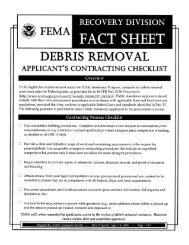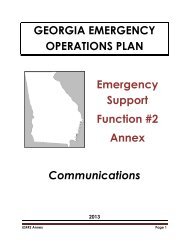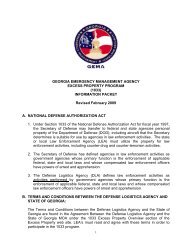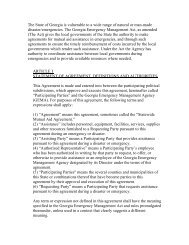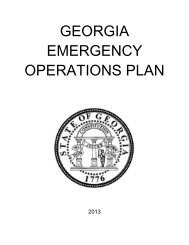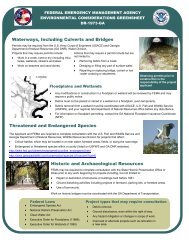FEMA: Debris Management Brochure - FEMA 329 - CT.gov
FEMA: Debris Management Brochure - FEMA 329 - CT.gov
FEMA: Debris Management Brochure - FEMA 329 - CT.gov
Create successful ePaper yourself
Turn your PDF publications into a flip-book with our unique Google optimized e-Paper software.
<strong>FEMA</strong>: <strong>Debris</strong> <strong>Management</strong> <strong>Brochure</strong> - <strong>FEMA</strong> <strong>329</strong><br />
<strong>Debris</strong> <strong>Management</strong> <strong>Brochure</strong> - <strong>FEMA</strong> <strong>329</strong><br />
●<br />
●<br />
●<br />
●<br />
●<br />
●<br />
Eligibility<br />
<strong>Debris</strong> <strong>Management</strong> Planning<br />
<strong>Debris</strong>-Related Contracts<br />
<strong>Debris</strong> Removal Monitoring<br />
Frequently Asked Questions<br />
Additional Resource Material<br />
Eligibility<br />
Public Assistance funds are available to eligible applicants for debris clearance, removal and disposal operations.<br />
Eligible applicants include State and local <strong>gov</strong>ernments, Indian tribes, and certain private nonprofit organizations. In<br />
order to be eligible for <strong>FEMA</strong> funding, the debris removal work must:<br />
●<br />
●<br />
●<br />
Be a direct result of a Presidentially declared disaster;<br />
Occur within the designated disaster area; and<br />
Be the responsibility of the applicant at the time of the disaster.<br />
In addition, at least one of the following must apply:<br />
●<br />
●<br />
●<br />
Removal eliminates immediate threats to human lives, public health and safety;<br />
Removal eliminates immediate threats of significant damage to improved public and private property; and/or<br />
Removal ensures economic recovery of the affected areas to the benefit of the community-at-large.<br />
<strong>Debris</strong> located on public property and rights-of-way is eligible. Eligible debris can include downed trees, sand,<br />
building wreckage, and damaged personal property.<br />
Generally, debris removal from private property is not eligible under the Public Assistance Program; however, <strong>FEMA</strong><br />
may approve debris removal from private property on a case-by-case basis when extenuating circumstances exist.<br />
Applicants should contact their State Emergency <strong>Management</strong> officials prior to debris removal for specific eligibility<br />
requirements. <strong>Debris</strong> that threatens private homes may be eligible under <strong>FEMA</strong>'s Individual Assistance Program.<br />
<strong>Debris</strong> <strong>Management</strong> Planning<br />
http://www.fema.<strong>gov</strong>/<strong>gov</strong>ernment/grant/pa/dmgbroch.shtm (1 of 4)06/29/2006 07:30:52
<strong>FEMA</strong>: <strong>Debris</strong> <strong>Management</strong> <strong>Brochure</strong> - <strong>FEMA</strong> <strong>329</strong><br />
A comprehensive debris management plan is a critical element in efficient recovery efforts when a disaster strikes.<br />
<strong>Debris</strong> management planning activities include the following:<br />
●<br />
●<br />
●<br />
●<br />
●<br />
●<br />
●<br />
●<br />
●<br />
●<br />
Identify the responsible debris operations managers within your organization.<br />
Contact your State Emergency <strong>Management</strong> officials for eligibility and contracting guidance.<br />
Procure standby debris removal and disposal contracts prior to the disaster. (Costs must be reasonable)<br />
Identify debris removal monitoring resources and staffing.<br />
Identify potential types and quantities of debris.<br />
Identify waste disposal methods (i.e., incineration, chipping, recycling, etc.).<br />
Identify and prepare debris storage and reduction sites:<br />
❍ Consider the proximity and affect on residential areas, educational facilities, and environmental<br />
features.<br />
❍ Collect baseline data. Video/photograph site. Take soil and ground water samples. Investigate<br />
potential historic or archaeological issues.<br />
❍ Determine site layout for storage, burning, grinding and other operations.<br />
❍ Provide buffer zones between areas within the site.<br />
❍ Provide ingress and egress to the site such that trucks do not delay normal traffic.<br />
❍ Construct inspection towers at ingress and egress locations.<br />
❍ Establish an environmental remediation and site restoration plan.<br />
Obtain appropriate Federal, State and local permits.<br />
Implement a regular public information campaign that instructs the general public on guidelines for dealing<br />
with debris.<br />
Ensure that costs are thoroughly documented and records are retained appropriately.<br />
<strong>Debris</strong>-Related Contracts<br />
Applicants may use their own forces or contract for debris removal and disposal work. When utilizing contractors,<br />
applicants should follow proper contracting procedures to ensure maximum reimbursement for eligible work.<br />
The following important points should be considered during the acquisition and oversight of debris removal and<br />
disposal contracts:<br />
●<br />
●<br />
●<br />
●<br />
●<br />
●<br />
●<br />
●<br />
All contracts should have a well-defined scope of work, specified costs, basis of payment, and performance<br />
schedule.<br />
Contracts must be competitively bid.<br />
Long-term contracts should be written on a unit price basis.<br />
Complete and accurate records of contractor activities should be kept by the applicant and are essential for<br />
receipt of federal funds.<br />
Contractor activities must be monitored by trained and knowledgeable applicant representatives.<br />
Time and materials (T&M) contracts are only allowed for the first 70 hours of response. After that point, the<br />
contracts must be competitively re-bid on a unit price basis.<br />
Unit price contracts are based on weights or volume of debris hauled and should be used when the scope of<br />
work is not well defined.<br />
Lump sum contracts are allowed but should be used only when the scope of work is clearly defined. An<br />
example of clearly defined work would be removal and disposal of an existing wood chip pile at a processing<br />
site.<br />
http://www.fema.<strong>gov</strong>/<strong>gov</strong>ernment/grant/pa/dmgbroch.shtm (2 of 4)06/29/2006 07:30:52
<strong>FEMA</strong>: <strong>Debris</strong> <strong>Management</strong> <strong>Brochure</strong> - <strong>FEMA</strong> <strong>329</strong><br />
●<br />
●<br />
Cost plus percentage of cost contracts are not allowed.<br />
<strong>FEMA</strong> does not certify or approve contracts or contractors.<br />
<strong>Debris</strong> Removal Monitoring<br />
Monitoring of debris removal and disposal contractor activities is a critical component in successful debris operations<br />
and in the justification and documentation of any application for <strong>FEMA</strong> Public Assistance funding. A successful<br />
debris monitoring plan will include the following activities:<br />
●<br />
●<br />
●<br />
●<br />
The applicant should deploy trained debris monitors to observe and document contractor activities. At a<br />
minimum, these monitors should be stationed at all pick-up and disposal sites.<br />
❍ Applicants may use their own full-time workforce or hire temporary workers as monitors;<br />
❍ Applicants may contract with local firms to provide debris monitoring services;<br />
❍ Applicants may request <strong>FEMA</strong>/State staff assistance for debris monitoring activities.<br />
For unit price contracts, applicants should use load tickets to document weights and volumes of contractor<br />
vehicles. These load tickets should be treated as accounting forms and represent critical documentation when<br />
applying for <strong>FEMA</strong> funds.<br />
❍ When unit price payments are based on weight, provisions should be made for weighing trucks at the<br />
disposal site. Periodically confirm empty weight of trucks.<br />
❍ When unit price payments are based on volume, monitors should verify truck capacities and inspect<br />
trucks for proper loading and compaction.<br />
For T&M contracts, applicants should document equipment and manpower time and ensure efficiency in<br />
usage. There is no reimbursement by <strong>FEMA</strong> for "down time" of equipment or manpower.<br />
Monitors should be on the look out for inappropriate contractor activities including: improper loading of<br />
trucks; picking up ineligible debris; posting trucks with inaccurate load capacities; etc.<br />
Frequently Asked Questions<br />
Q: How does my community get <strong>FEMA</strong> funding for debris removal<br />
A: Local <strong>gov</strong>ernments and other eligible applicants should contact their State's Emergency <strong>Management</strong> officials to<br />
discuss obtaining, completing and submitting a Request for Public Assistance form. Upon receipt of this request form<br />
from the State, <strong>FEMA</strong> will assign a Public Assistance Coordinator (PAC) to work with each applicant.<br />
Q: Are there specialists that can help my community manage its debris issues<br />
A: Yes. <strong>FEMA</strong> has debris specialists that can be mobilized to a declared disaster location to assist applicants with<br />
debris management. Contact your State or Tribal Emergency <strong>Management</strong> Office for assistance.<br />
Q: What kind of debris training is available<br />
A: <strong>FEMA</strong> offers an Emergency <strong>Management</strong> Institute (EMI) Independent Study course, IS 632- Introduction to<br />
<strong>Debris</strong> Operations, which is a CD-ROM computer based training course. Applicants can enroll at www.training.fema.<br />
<strong>gov</strong>/EMIWeb/enroll.htm or by calling the Independent Study office at 301- 447-1200. <strong>FEMA</strong> also provides classroom<br />
instruction in debris management for State, Tribal and Local officials at EMI in Emmitsburg, MD.<br />
http://www.fema.<strong>gov</strong>/<strong>gov</strong>ernment/grant/pa/dmgbroch.shtm (3 of 4)06/29/2006 07:30:52
<strong>FEMA</strong>: <strong>Debris</strong> <strong>Management</strong> <strong>Brochure</strong> - <strong>FEMA</strong> <strong>329</strong><br />
Q: Are the costs of contract monitoring eligible for <strong>FEMA</strong> funding<br />
A: Yes. Overtime incurred by applicant forces, reasonable costs for contracted debris monitoring services, and costs<br />
for temporary monitors hired by the applicant, are eligible for <strong>FEMA</strong> reimbursement.<br />
Q: If I have an existing T&M contract in place, can I convert it to unit price after 70 hours without rebidding<br />
A: No. The T&M contract must be competitively rebid on a unit price basis. However, if a few hours of work remain,<br />
an extension may be provided in order to complete the work.<br />
Q: Does <strong>FEMA</strong> pay for debris on privately owned land<br />
A: Generally no, however, disaster-related debris from private property brought to the curbside for public pickup is<br />
usually covered.<br />
Q: Does <strong>FEMA</strong> have to approve my debris removal and disposal contracts<br />
A: No. <strong>FEMA</strong> does not approve contracts; however, <strong>FEMA</strong> can provide technical assistance to applicants regarding<br />
proper contracting procedures. Prior to contract execution, it is recommended that you provide a copy of your contract<br />
to the State Emergency <strong>Management</strong> Office and <strong>FEMA</strong>.<br />
Q: Is debris generated by post-disaster reconstruction activities eligible<br />
A: No. This type of debris is the owner's responsibility and generally covered by insurance.<br />
Additional Resource Material<br />
The following reference guides can be downloaded from <strong>FEMA</strong>'s website at www.fema.<strong>gov</strong>/<strong>gov</strong>ernment/grant/pa/<br />
padocs.shtm or ordered from the <strong>FEMA</strong> Publications Office at 800-480-2520:<br />
●<br />
●<br />
●<br />
●<br />
<strong>FEMA</strong> 321 - Public Assistance Policy Digest<br />
<strong>FEMA</strong> 322 - Public Assistance Guide<br />
<strong>FEMA</strong> 323 - Applicant Handbook<br />
<strong>FEMA</strong> 325 - Public Assistance <strong>Debris</strong> <strong>Management</strong> Guide<br />
http://www.fema.<strong>gov</strong>/<strong>gov</strong>ernment/grant/pa/dmgbroch.shtm (4 of 4)06/29/2006 07:30:52




